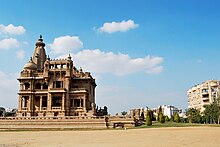In 1906, Empain established the Cairo Electric Railways and Heliopolis Oases Company, which bought a very large stretch of desert (25 square kilometres) to the northwest of Cairo at a low price from the colonial government.Commencing in 1906-07 this company proceeded with the building of the new town of Heliopolis, in the desert ten kilometers from the center of Cairo. It was designed as a "city of luxury and leisure", with broad avenues and equipped with all necessary conveniences and infrastructure; water, drains, electricity, hotel facilities, such as the Heliopolis Palace Hotel (now the presidential palace of Hosni Mubarak) and Heliopolis House, and recreational amenities including a golf course, racetrack and park. In addition, there was housing for rent, offered in a range of innovative design types targeting specific social classes with detached and terraced villas, apartment buildings, tenement blocks with balcony access and workers' bungalows.
Today, Baron Empain is perhaps best known by modern visitors to Egypt for the building of a palace (the Palais Hindou) in the Avenue des Palais (renamed Orouba Avenue in the Nasser era) Heliopolis, Egypt. Inspired by Angkor Wat in Cambodia and the Hindu temples of Orissa, the Baron Empain palace was designed by French architect Alexandre Marcel (1860-1928) and decorated by Georges-Louis Claude (1879-1963), with construction being completed in 1911.
In 1905, Empain assisted the Belgian government in the purchase of an Old Kingdom mastaba for the royal museum in Brussels, of which he was a benefactor. In 1907 he received the title of Baron, and also suggested to Belgian Egyptologist Jean Capart that he excavate at Heliopolis, where his building constructions were underway. He also made it possible for Capart to acquire some fine ancient artefacts for the Brussels Museum.










No comments:
Post a Comment